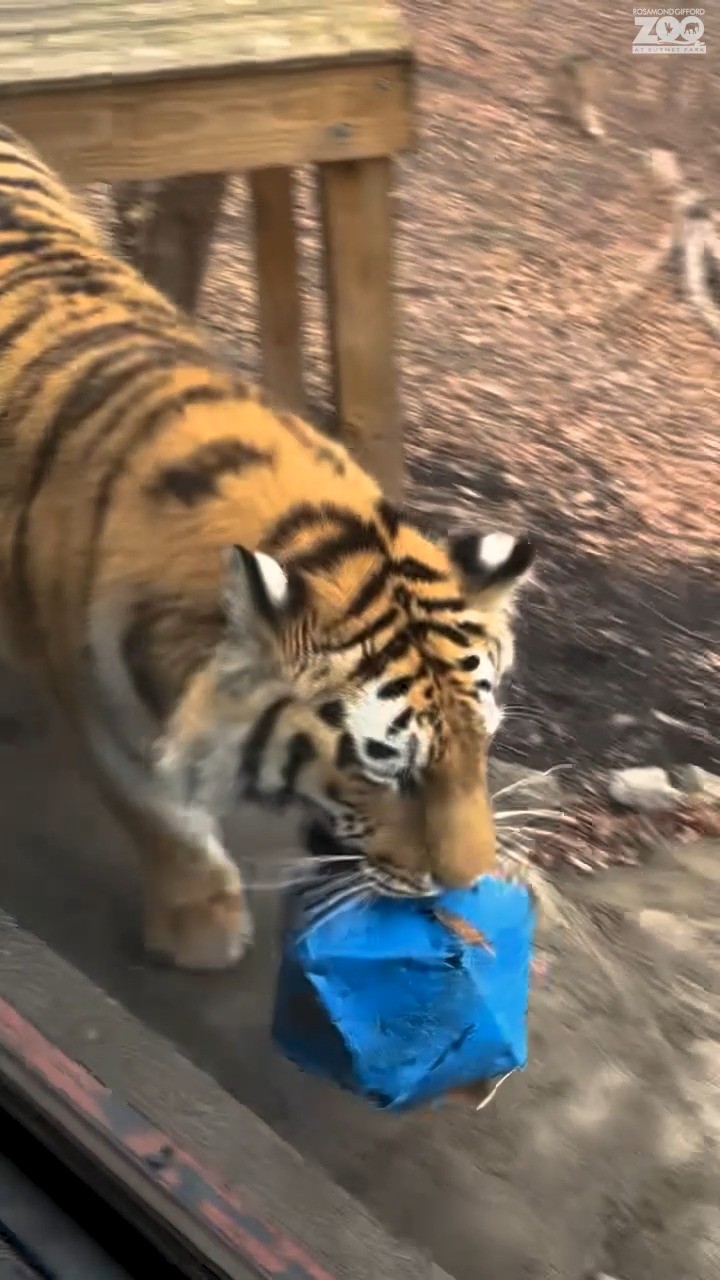- Explore the behavioral patterns and enrichment of Amur tigers in captivity.
- Discuss the significance of enrichment activities in enhancing the mental and physical well-being of zoo animals.
- Highlight zoo management practices that facilitate active engagement and conservation efforts for large carnivores like Amur tigers.
- Explain the role of digital content, such as videos, in raising awareness and fostering a connection between the public and wildlife conservation.
- Emphasize the importance of collaboration between zoologists and digital media professionals in promoting conservation messages.
Amur tigers, also referred to as Siberian tigers, constitute one of the most majestic creatures inhabiting the Siberian taiga. These big cats are not only one of the largest tiger species but are also endangered, making their presence in zoos pivotal for conservation research and public education. Observing an Amur tiger such as Coba engage in playful activities is a testament to the thoughtful care provided by dedicated zoo professionals, underscoring the tiger’s natural behavior and inherent curiosity.
Large carnivores in captivity require carefully structured environments to thrive both physically and mentally. Enrichment activities, like those designed for Coba, are integral to emulating the varied stimuli present in their natural habitats. Enrichment encompasses creating complex environments that stimulate the animals’ senses and natural instincts. This can involve simple tools, such as balls or cardboard boxes, that encourage interactive play and cognitive problem-solving, mimicking hunting and exploration behaviors. For instance, Coba’s decision to forsake a meaty treat in favor of a cardboard box illustrates her engagement with and curiosity about her surroundings, demonstrating behaviors crucial for her species.
Zoo environments are curated to meet the physical and psychological needs of their inhabitants, ensuring that animals like Coba gain opportunities to explore and express natural behaviors. Providing a rich variety of stimuli addresses play behavior, which is essential for cognitive development and stress reduction. Enrichment activities serve to prevent the onset of stereotypical behaviors that can develop from boredom or confinement. As part of zoo management, keepers carefully observe and record how these activities affect each animal, adjusting plans to perpetuate the well-being and health of their charges.
The management of carnivores within zoological settings involves a synergy of ethical practices and conservation efforts. Zoos function as crucial centers for wildlife conservation, offering education, breeding programs, and platforms for scientific research that contribute to species preservation. The collaboration of wildlife experts, veterinarians, and animal behaviorists is vital in crafting environments and routines promoting longevity and vitality in tigers like Coba. Effective management adheres to the best practices and standards set by zoological associations, ensuring the animals’ safety and well-being while fostering a deeper public understanding of these magnificent creatures.
Engagement with the public, however, extends beyond in-person visits. In our digital age, sharing visual content that showcases the playful antics and daily lives of zoo animals has become an influential tool in conservation messaging. Videos of Amur tiger Coba, for example, allow people to witness intimate and spontaneous moments that might otherwise remain unseen. Through platforms such as Instagram, zoo visitors and supporters can gain insights into animal care and the intricate personalities of individual animals.
Digital storytelling plays a crucial role in expanding the reach of conservation messages. By capturing the charming and lively behavior of animals like Coba, videos can elicit emotional connections and inspire action toward conservation efforts. This form of media brings audiences closer to wildlife, fostering empathy and intellectual curiosity about the natural world and the threats animals face in the wild.
The importance of collaboration between zoo personnel and digital media creators cannot be underestimated. Wildlife experts possess the knowledge necessary to ensure accurate and respectful representations of animals, while media professionals leverage their skills to disseminate these messages effectively. Such partnerships not only enhance public awareness but also contribute to a culture of conservation-minded citizens who value and advocate for biodiversity.
In conclusion, the playful activities of the Amur tiger Coba, when captured in video form, serve as potent reminders of both the complex needs and captivating traits of these majestic animals. This convergence of animal care, advanced zoo management practices, and innovative digital media efforts fosters a supportive environment for the preservation of tigers and countless other species. Through education, enrichment, and engagement, we continue to strengthen the bonds between humans and the remarkable biodiversity that shares our planet.
*****
Source Description
Members of our Carnivore Department got some adorable videos of Amur tiger Coba playing with some enrichment! Check out this video to see her drop her ball in favor of batting a cardboard box down from her tree. And instead of eating the meaty treat inside of it, she just steals the box! 🐯
Videos from Marshall Hildreth & Emily Braun


